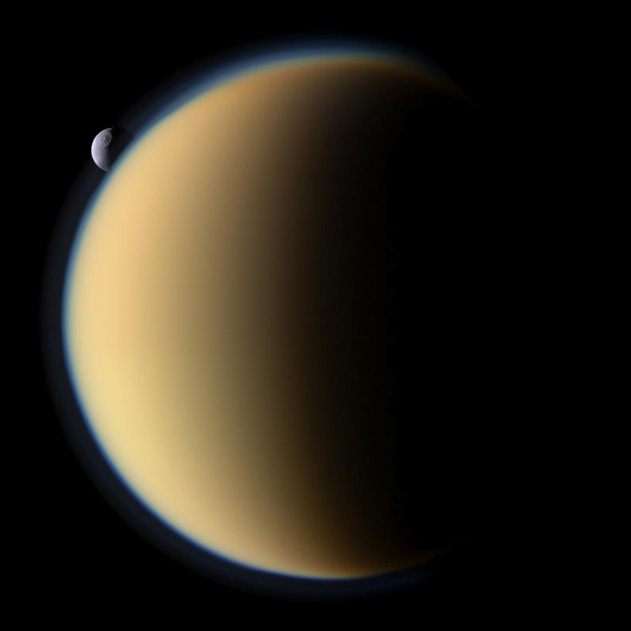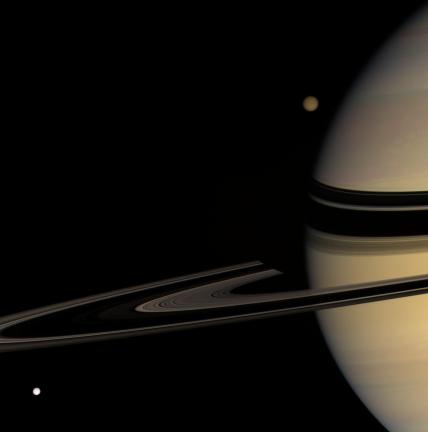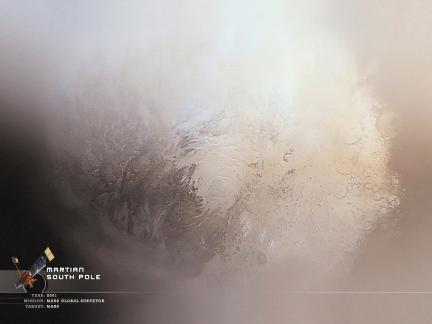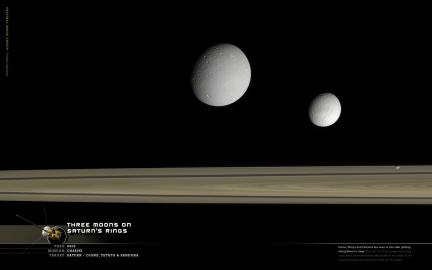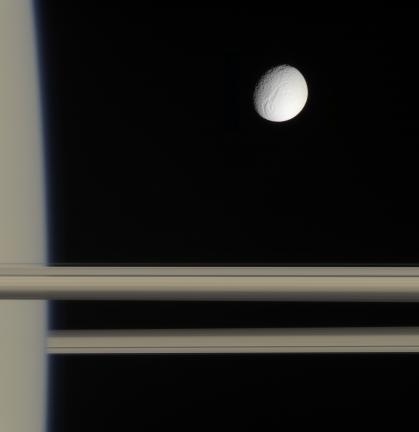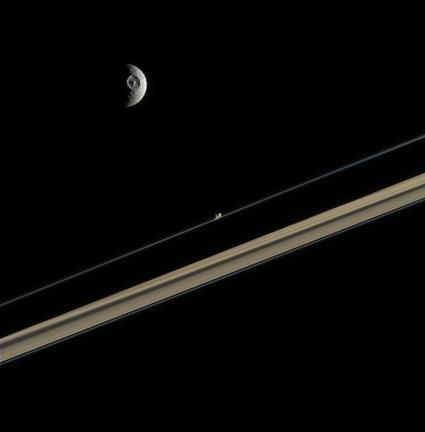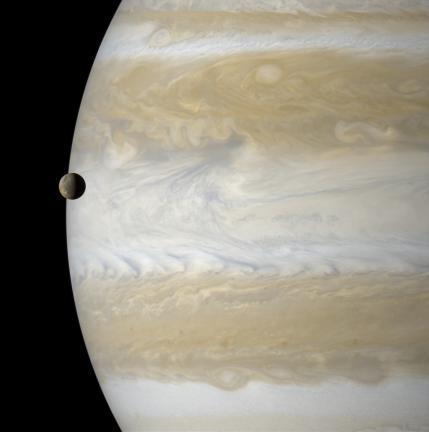Taken 2006. Posted by landru79.
Around Saturn
Around Saturn from fabio di donato on Vimeo.
In Saturn’s Rings Official Trailer
The long awaited official trailer for “In Saturn’s Rings” has been unleashed. Looking forward to this film for over three years now.
Titan and Friends
Titan and friends from recent official Cassini mission releases.
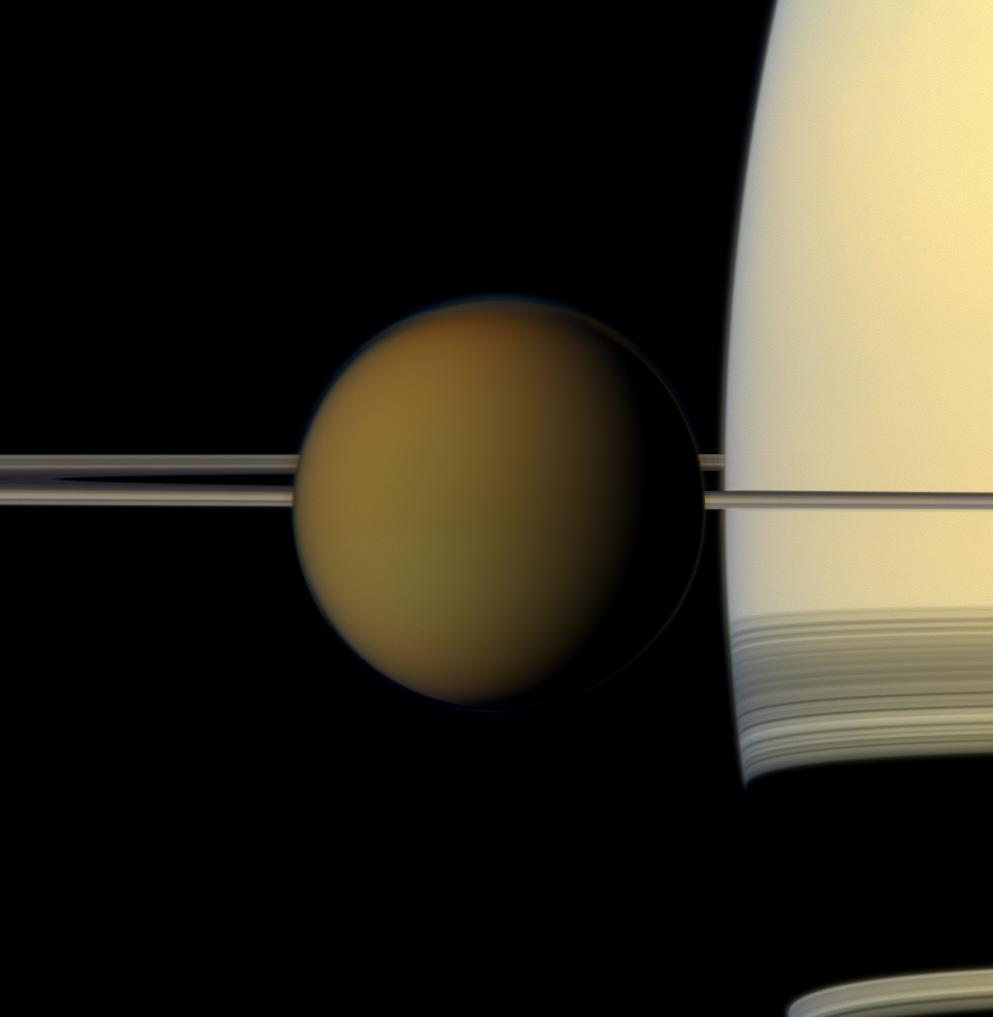
Shown with Saturn
Shown with Dione against a Saturn and rings nearly edge-on in the background. Looks like a NASA re-interpretation of this image.
With Tethys against more edge-on rings.
Tethys at the Edge of Titan
50 Years of Space Exploration Map
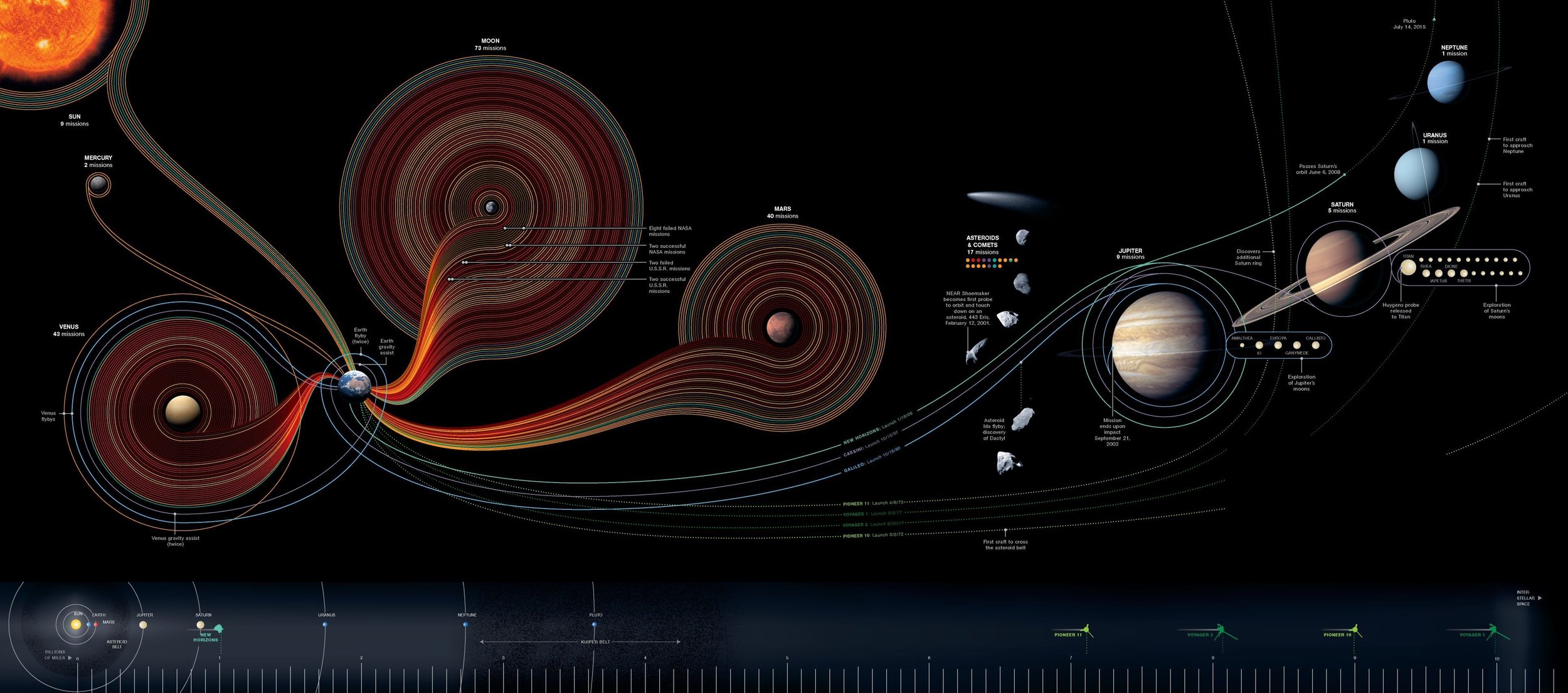 This is so nice, but I am furious that I didn’t get to design this. This is Information design at it’s best naturally by National Geographic. You can see 50 years of robotic planetary exploration at a glance. It even includes failed missions represented by darker desaturated lines. As far as I can tell the cream colored lines are US and the red ones are Soviet. Interesting to see how many of those lines go dark around Mars.
This is so nice, but I am furious that I didn’t get to design this. This is Information design at it’s best naturally by National Geographic. You can see 50 years of robotic planetary exploration at a glance. It even includes failed missions represented by darker desaturated lines. As far as I can tell the cream colored lines are US and the red ones are Soviet. Interesting to see how many of those lines go dark around Mars.
Now where does one purchase such a thing? Perhaps this month’s issue of NG? Here is the link to it on their site complete with zoom viewer and them some kind samaritan posted a hires version to flickr.
Saturnati XXII
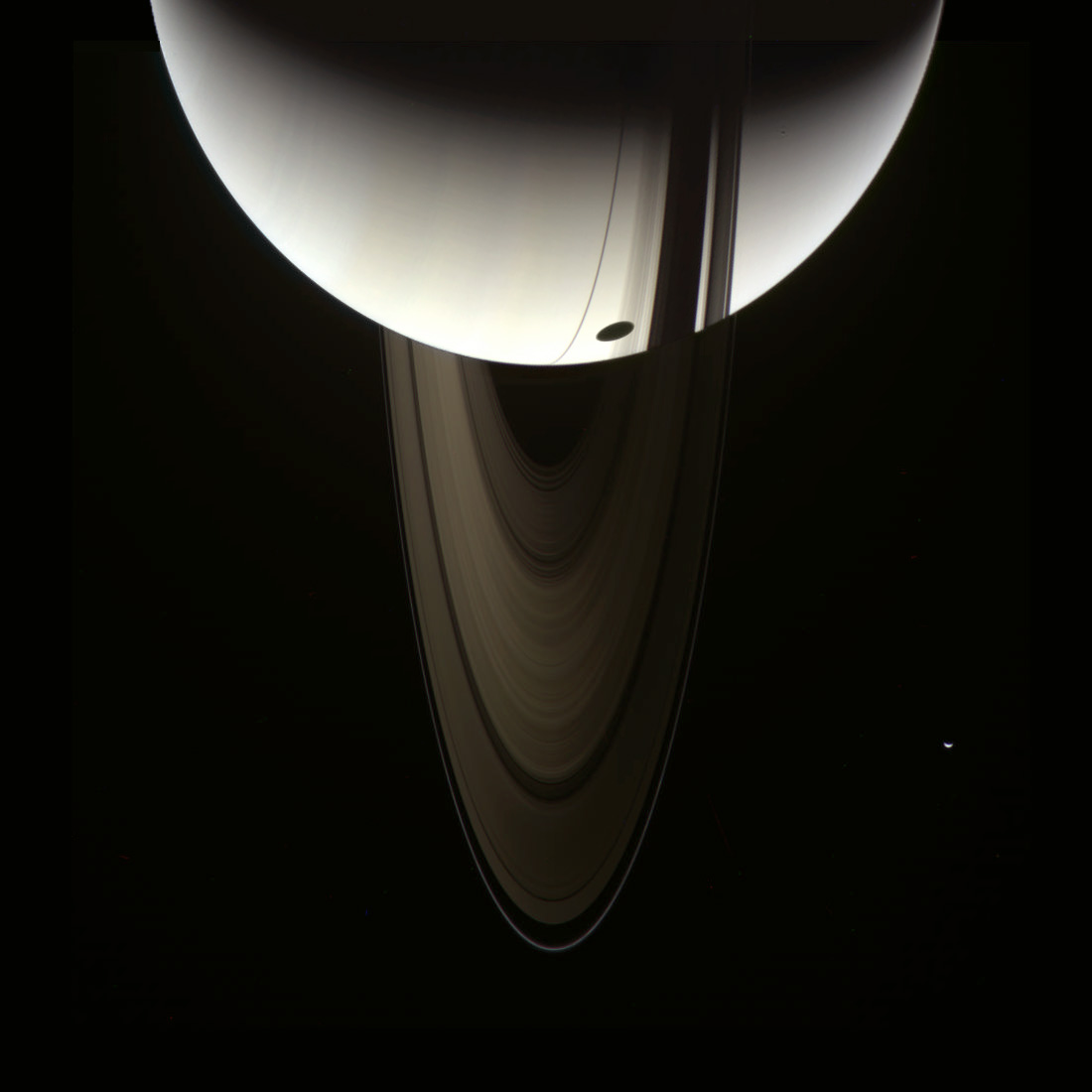 Emily Lakdawalla recently posted some images from the Cassini raw image database and I noticed that she had posted 2 similar images taken the same day. One had Saturn’s disc over exposed and the other had Saturn exposed much better with the rings too dark and lacking detail. These crescent images often make it difficult for Cassini’s cameras to get a single exposure with both elements with proper exposure because Saturn’s disk is so much brighter than the back-lit rings.
Emily Lakdawalla recently posted some images from the Cassini raw image database and I noticed that she had posted 2 similar images taken the same day. One had Saturn’s disc over exposed and the other had Saturn exposed much better with the rings too dark and lacking detail. These crescent images often make it difficult for Cassini’s cameras to get a single exposure with both elements with proper exposure because Saturn’s disk is so much brighter than the back-lit rings.
So i retrieved the images from the same day, recompiled them, did a little manual color balancing based on one of Gordan Ugarkovic’s recent crescent Saturn images and finally merged the two elements together. So, in reality the rings were taken at a slightly different time than Saturn’s disc was. However, since Cassini takes it’s color images one filter at a time (red, green and then blue), that is really true of any color image compiled from the mission database.
Also visible in the image is a small crescent Tethys and Titan’s shadow on the cloud tops.
Tethys and Saturnian Rings
Saturnati XIV
Cassini Team Shows Some Color
NASA released an unusually large amount of color images to the Cassini website recently. Most of what is shown here on this site are actually images put together by freelance imagers who access the raw files and do some stitching together of filtered images. Color images coming straight off the Cassini website are a rare event, so when about 8 appeared in the gallery a few days ago… it was an unexpected gift.
 Saturn as seen from the unlit side of the rings.
Saturn as seen from the unlit side of the rings.
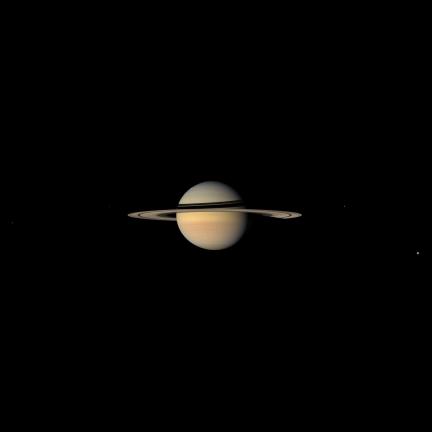 A family portrait of the Saturn System. Moons visible in this image (you need to click the preview) are Dione at far left, Enceladus near the left side ring edge, Mimas a speck on ring shadows on the western limb, Rhea against the northern hemisphere, Tethys near the right ring edge, and Titan near lower right.
A family portrait of the Saturn System. Moons visible in this image (you need to click the preview) are Dione at far left, Enceladus near the left side ring edge, Mimas a speck on ring shadows on the western limb, Rhea against the northern hemisphere, Tethys near the right ring edge, and Titan near lower right.
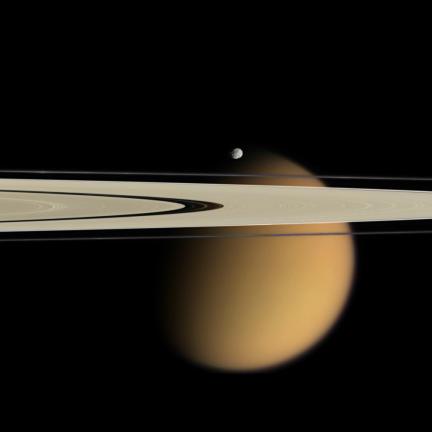 Titan and a small moonlet named Epimetheus share the frame with Saturn’s rings.
Titan and a small moonlet named Epimetheus share the frame with Saturn’s rings.
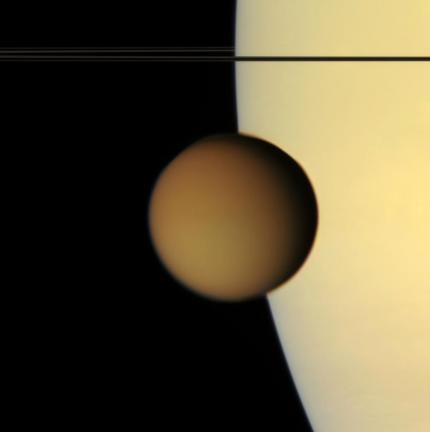 A rare color view of both Saturn and Titan in one frame. This is the only one of its kind thus far in the mission.
A rare color view of both Saturn and Titan in one frame. This is the only one of its kind thus far in the mission.
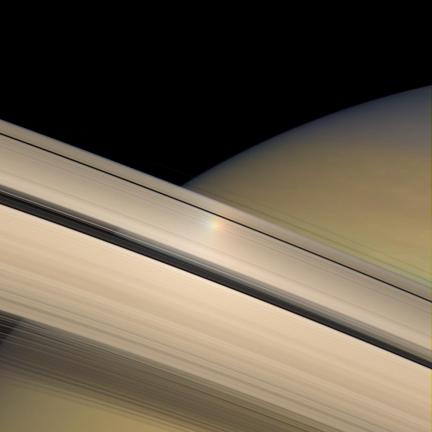 A small rainbow appears as sunlight streams through Saturn’s rings.
A small rainbow appears as sunlight streams through Saturn’s rings.
Wallpapers: 1024x768 Set 05
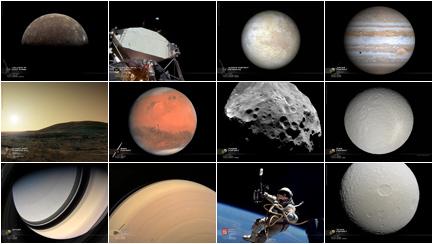 Managed to make the more common wallpaper size 1024x768 for the 14 most recent wallpaper posts (started with set 05 images, 1-4 to come). Download zip file here. Some were not produced as they just didn’t translate so easily into the format. However, the opposite is true in some cases such as for this image of the Martian south pole. Its resolution was hopelessly low for the larger landscape format, so now with the smaller size it was possible (just barely) to get it posted as a wallpaper.
Managed to make the more common wallpaper size 1024x768 for the 14 most recent wallpaper posts (started with set 05 images, 1-4 to come). Download zip file here. Some were not produced as they just didn’t translate so easily into the format. However, the opposite is true in some cases such as for this image of the Martian south pole. Its resolution was hopelessly low for the larger landscape format, so now with the smaller size it was possible (just barely) to get it posted as a wallpaper.
Included in the set for download are the images pictured at the top and for the sake of google search, here they are listed out:
- 1024x768 Wallpaper of CALLISTO at half view, moon of JUPITER
- 1024x768 Wallpaper of EARTH from APOLLO landing site
- 1024x768 Wallpaper portrait of EUROPA, moon of JUPITER
- 1024x768 Wallpaper portrait of JUPITER
- 1024x768 Wallpaper of MARS region of DEUTERONILUS (not shown)
- 1024x768 Wallpaper of MARS surface at HUSBAND HILL
- 1024x768 Wallpaper portrait of MARS
- 1024x768 Wallpaper portrait of PHOEBE, moon of SATURN
- 1024x768 Wallpaper portrait of RHEA, moon of SATURN
- 1024x768 Wallpaper of SATURN, crescent view (not shown)
- 1024x768 Wallpaper of SATURN from above the NORTHERN POLE
- 1024x768 Wallpaper of SATURN globe
- 1024x768 Wallpaper of SPACE WALK
- 1024x768 Wallpaper portrait of TETHYS, moon of SATURN
Active Bodies List: Dione and Tethys
For those keeping score… the active bodies in the Solar System list may now include Dione and Tethys at Saturn. See article here - spacespin.org.
Wallpaper: Tethys Portrait
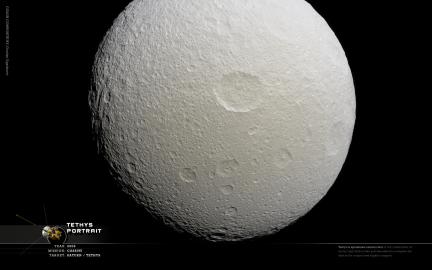 One of the mid-sized moons of Saturn, Tethys, is thought to be composed almost entirely of water ice. Its most remarkable features are Odysseus, a 400 km wide crater and the Ithaca Chasma a 2,000 km long valley that runs across 2/3 of Tethy‘s globe. Those features are not visible in this image, but what is visible is the slight color variation which almost appears as a “dusting” of color on a largely grey body. A curious feature especially considering the radical color variation found at Iapetus. Perhaps this discoloring is a more subtle result of the same event which caused the strange color variation on Iapetus?
One of the mid-sized moons of Saturn, Tethys, is thought to be composed almost entirely of water ice. Its most remarkable features are Odysseus, a 400 km wide crater and the Ithaca Chasma a 2,000 km long valley that runs across 2/3 of Tethy‘s globe. Those features are not visible in this image, but what is visible is the slight color variation which almost appears as a “dusting” of color on a largely grey body. A curious feature especially considering the radical color variation found at Iapetus. Perhaps this discoloring is a more subtle result of the same event which caused the strange color variation on Iapetus?
Image Processors on Flickr: Gordan Ugarkovic
Gordan Ugarkovic has a great collection of reworked Cassini images on Flickr. I contacted Gordan about showing some of his images here on wanderingspace and he was ever so gracious. As many people Gordan is “somewhat underwhelmed by the frequency the Cassini Imaging Team releases color composites”, so it is up to excellent freelancers like him to compile this information from the data files which are made public by NASA. Problem is that these images rarely make it to the mass media and we are stuck with the dozen or so color images the NASA imaging teams decide to produce in a year.
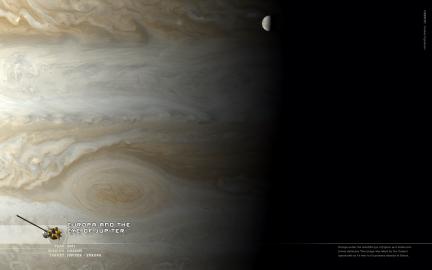
WALLPAPER NOTE: The left 1/3 of the “Three Moons” image was extended in Photoshop using data at the edges of the original image which was cropped to a square format. This “fake” imagery was only applied to that area of the rings and the rest of the image including the moons is actual.
Here are some other images from Gordan which are some of my favorites, but don’t trust my editing… go to the gallery and have a look yourself. For the sake of posterity I have added a permanent link to his gallery on the right side of this blog where you may note that there are already a few others linked. There were two additional ones but the sites have been taken down since I linked to them?! Hopefully the three left will stick around for a while and I will in time add more to the collection.
Tethys and Saturn’s Hazy Limb
Mimas and Prometheus on Rings
Io on Jupiters Edge
Wallpaper: Tethys and Saturn
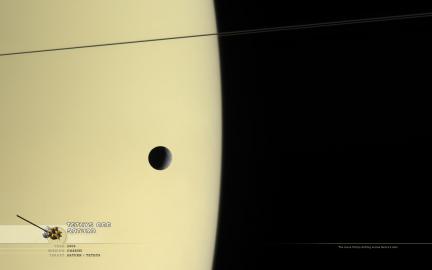 The moon Tethys is pictured drifting across Saturn’s disc. Tethys is one of 3 medium sized moons (including Rhea and Dione) which are largely composed of ice with small amounts of rock and whose features consist mostly of craters. Tethys does have two outstanding features which are a huge 400km impact crater whose diameter is about 2/5 that of Tethys itself, as well as a giant 2000km valley that stretches across 3/4 of Tethys diameter.
The moon Tethys is pictured drifting across Saturn’s disc. Tethys is one of 3 medium sized moons (including Rhea and Dione) which are largely composed of ice with small amounts of rock and whose features consist mostly of craters. Tethys does have two outstanding features which are a huge 400km impact crater whose diameter is about 2/5 that of Tethys itself, as well as a giant 2000km valley that stretches across 3/4 of Tethys diameter.
IMAGE NOTE: This image was not altered other than extending Saturn’s rings to fill the page on the upper right side. The original image was in square format so the subtle ring outlines were more cropped than seen here.



